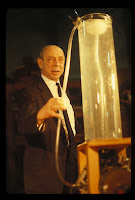There were no direct flights from Los Angeles to Kampala. Megan and Aaron had to hop-scotch continents, from Washington, D.C. to Italy, and then Italy to Ethiopia to catch a flight to Kampala, Uganda. It took days to get there.
At the Entebbe Airport they were met by two Life In Africa representatives, Peter and Gilbert, who then drove them to LIA headquarters. After they recovered from jet-lag, Megan and Aaron undertook an intensive LIA orientation to prepare them to work with artisans and teach art classes to children. Then they were off to Gulu in northern Uganda where the Invisible Children stayed.
“We rented a mini van and one of the other LIA organizers, Grace, went up with us. It took four or five hours… We crossed the Nile. It was beautiful. Heavy rapids. Monkeys everywhere. We also saw baboons,” Aaron shares.
|
Along the way, they gave a lift to two young government soldiers with huge guns that had rounds of clips. “They dropped one of the guns. I flinched. I was sure it would go off. These guys were ready for WWIII.”
They stayed at a compound with the Invisible Children and then moved into a hostel for IC volunteers, where Aaron would see Bobbie Bailey and Laren Poole, who were deeply involved in film work. By day Aaron taught LIA art classes and by night hung out with other IC volunteers. At night they were grateful for the safe house, as they heard LRA gunfire in the jungle. Michael, David and Tony – Aaron’s closest friends -- were, themselves, Invisible Children who had had family members killed by the LRA.
|
Because of Aaron’s high school computer skills, he transitioned from teaching Life In Africa art classes to kids to teaching typing and basic computer skills to adults for the Invisible Children organization using low energy computers.
“There were rolling black outs every week. In Gulu the power would be off for a week at a time. You had to haul your own water from a well to the compound in these huge yellow plastic bottles like gas cans. We took sponge baths or cold showers.”
Aaron worked for two months as a volunteer in Uganda, where he celebrated his 19th birthday. “I’m really happy that I did this, that I worked in Uganda and got to know people. That it wasn’t a vacation. I didn’t stay in a fancy hotel.”
“I think it’s important to help people make their lives better,” says Aaron. “When I was there, there were no public schools - only private schools, so only families with money could afford education. Invisible Children is helping to support children with scholarships to get an education. Life In Africa is trying to help build infra-structure, putting money back into the community to build houses, schools, provide electricity – through art. And there are other groups that are trying to help also.”
|
|
As of this writing, Joseph Kony, the leader of the Lord’s Resistant Army, is still at large. Invisible Children has a real-time network - the LRA Crisis Tracker – that sends out warnings in the areas where LRA is believed to be active. For more information, please visit: www.invisiblechildren.com
For more information about Life In Africa Uganda and Life In Africa USA foundations,
please visit: http://lifeinafrica2.com
update on 3/8/12
please visit: http://lifeinafrica2.com
update on 3/8/12
After this blog posted, these sites featured the filmmakers of Invisible Children and their worldwide campaign focus on the creation of Joseph Kony Day - April 20, 2012 - to demand policymakers focus on the capture of Joseph Kony as a top priority.
To see the Kony 2012 Documentary and learn more, please visit:
http://media.theage.com.au/system/ipad/kony-2012-documentary-3107430.html
video.pbs.org/video/2208001602
Shän Boggs is a writer and editor living in California. Aaron Gentry Boggs is her son.


















